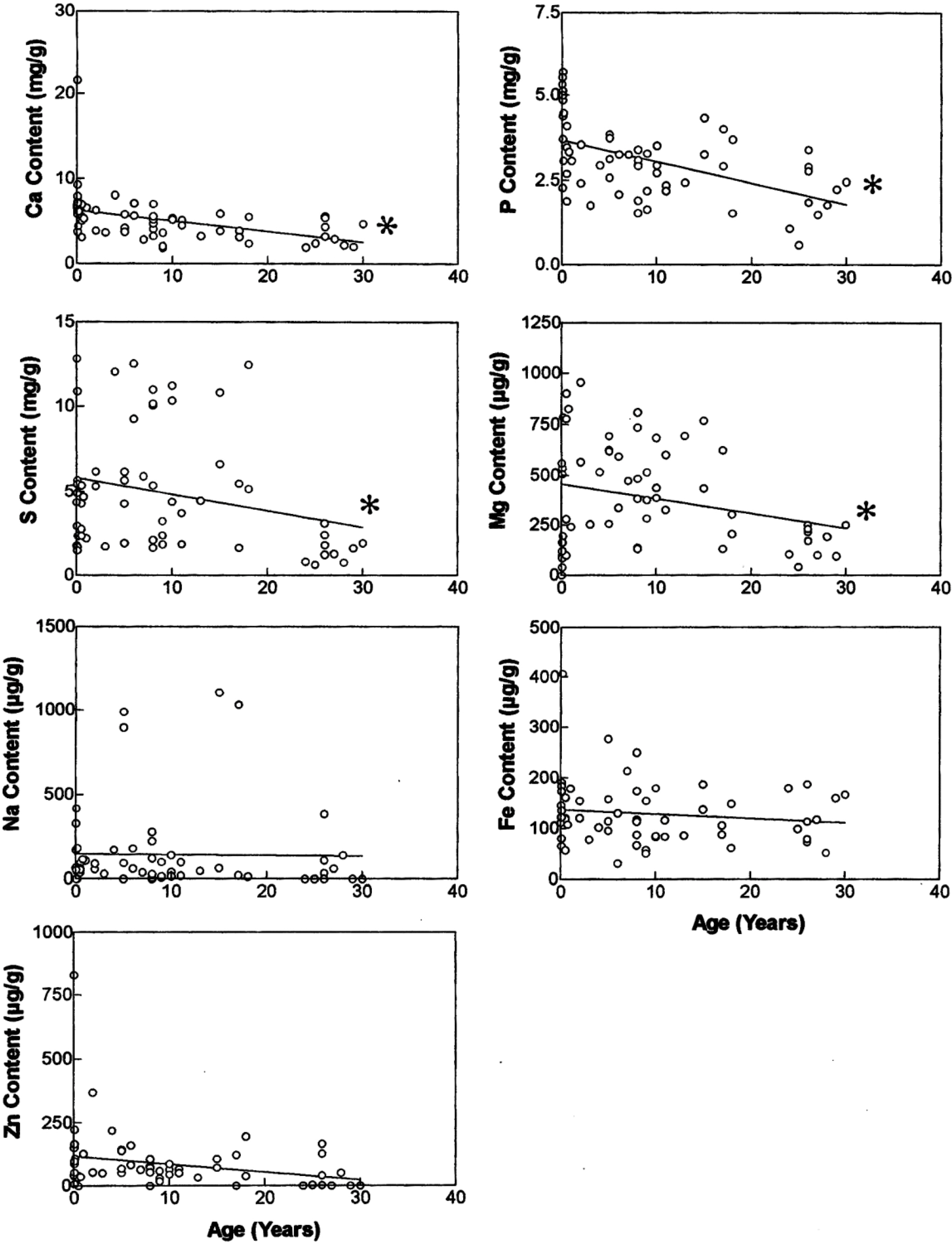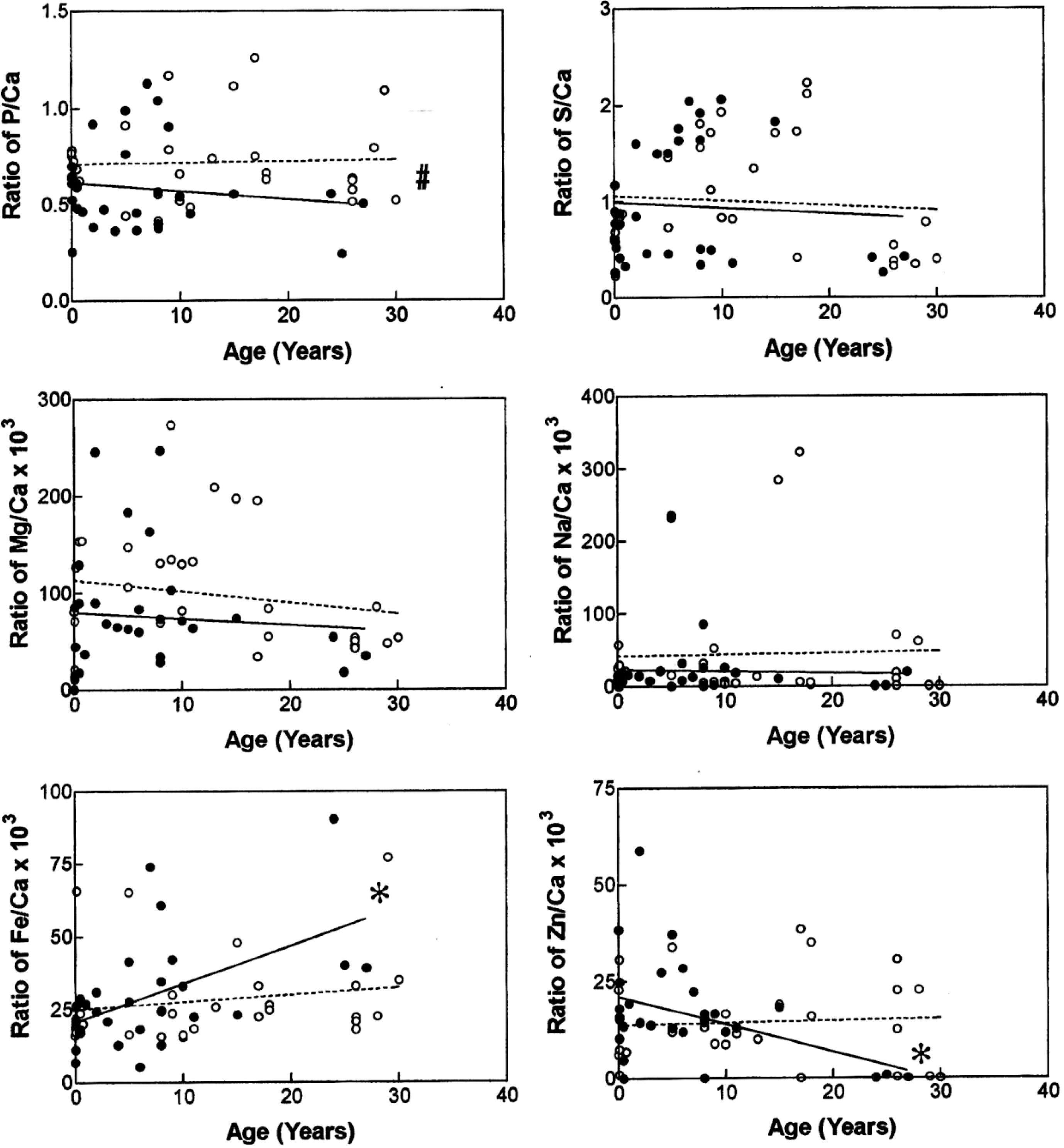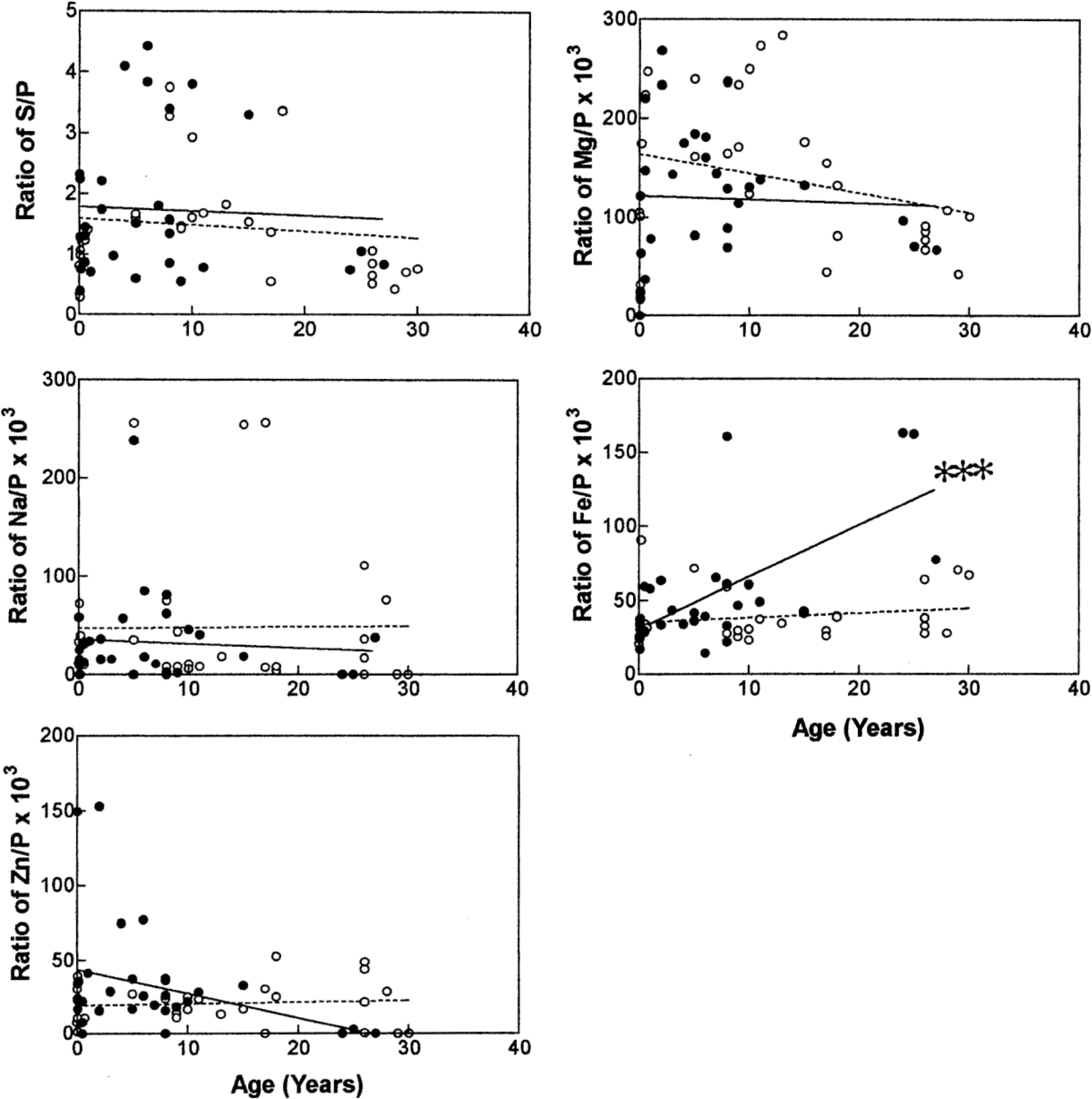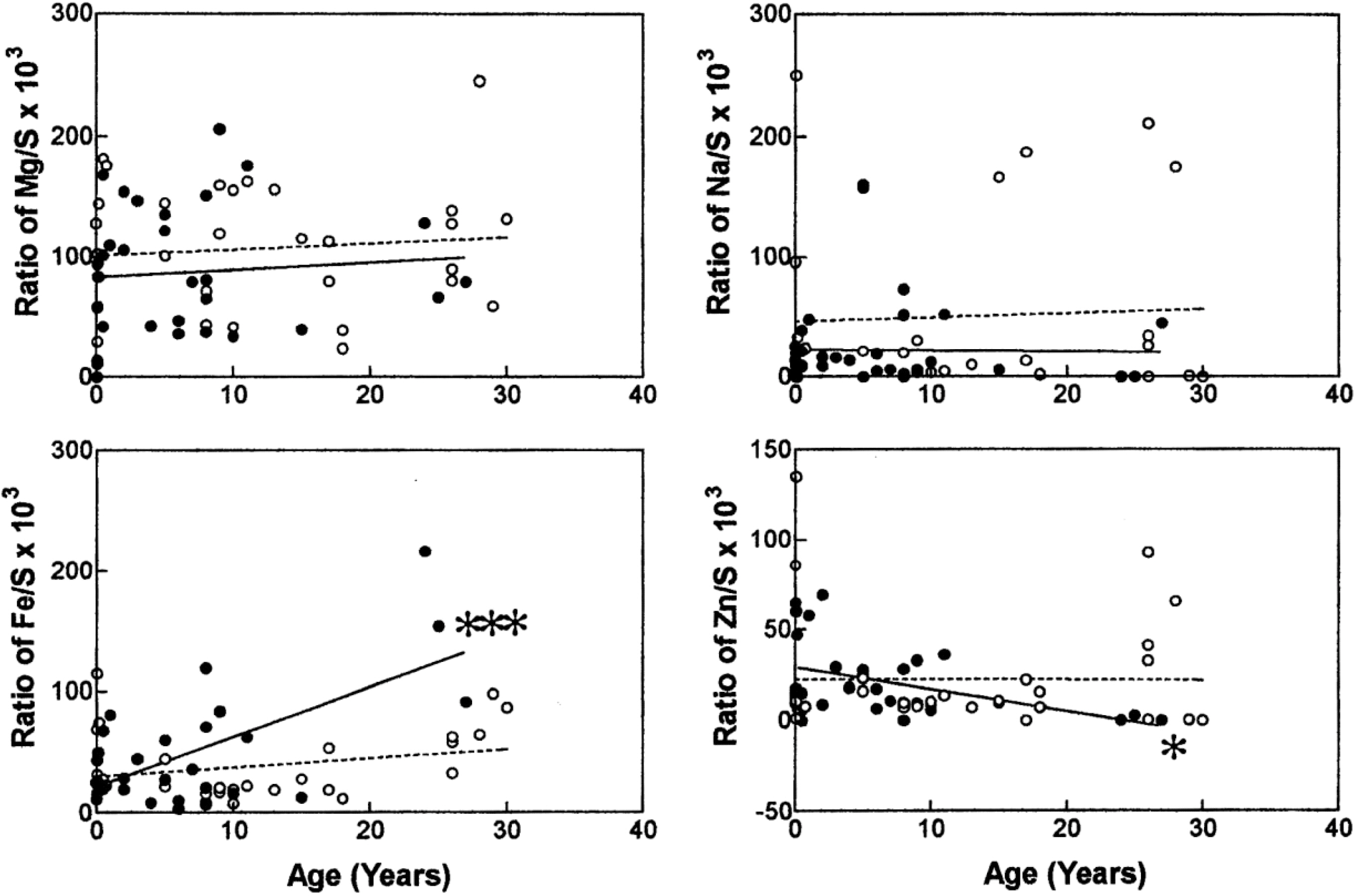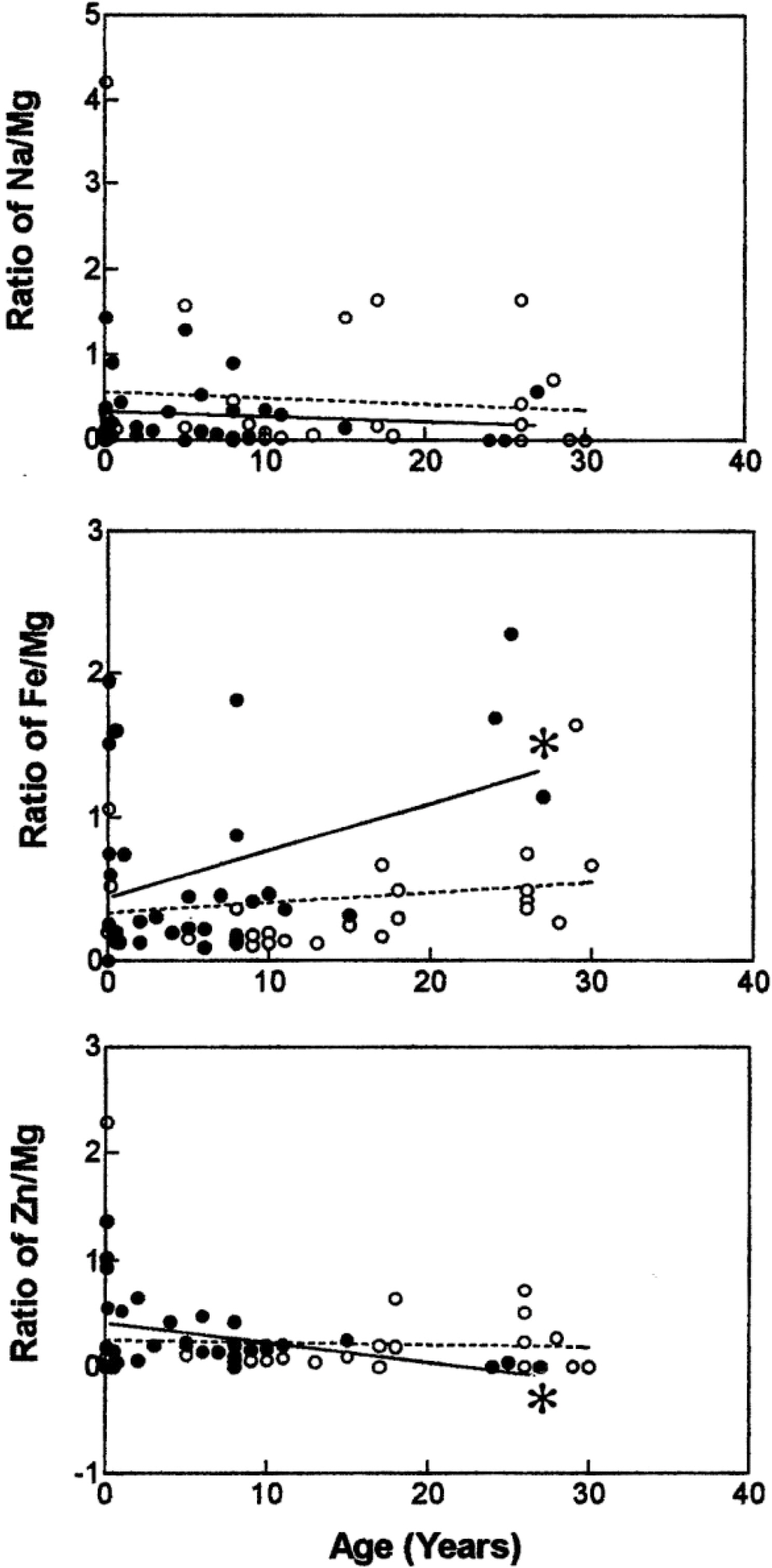Korean J Physiol Pharmacol.
2010 Oct;14(5):249-256. 10.4196/kjpp.2010.14.5.249.
Gender-Related Differences in a Process of the Age-Dependent Alterations of the Elements in Monkey Sino-Atrial Node
- Affiliations
-
- 1Department of Pharmacology, Division of Molecular and Cellular Biology, Kashihara, Nara University 634-8521, Japan. hysat@naramed-u.ac.jp
- 2Department of Anatomy, Faculty of Medicine, Chiang Mai University, Chiang Mai 50200, Thailand.
- 3Laboratory of Environmental Biology, Department of Life Science, Faculty of Science and Engineering, Kinki University, Higashi-Osaka, Osaka 577-8502, Japan.
- 4Department of Cellular and Molecular Biology, Primate Research Institute, Kyoto University, Inuyama, Aichi 484-8506, Japan.
- KMID: 2071690
- DOI: http://doi.org/10.4196/kjpp.2010.14.5.249
Abstract
- Gender differences in the trace elements of monkey sino-atrial (SA) node were investigated in a process of age-dependent alterations. Sixty hearts from Japanese and rhesus monkeys (30 male and 30 female) used were aged ranging from 1-day- to 30-year-old. The elements were analyzed using an inductively coupled plasma-atomic emission spectrometer (ICP-AES). Advancing age decreased all the trace elements. Ca, P, S and Mg significantly decreased. The correlation coefficients of Ca and P were -0.178+/-0.081 (p<0.05) and -0.088+/-0.022 (p<0.05) in male (n=30), and -0.095+/-0.026 (p<0.05) and -0.069+/-0.017 (p<0.05) in female (n=30), respectively. The age-dependent coefficients for Fe/Ca, Zn/Ca, Fe/P, Fe/S, Zn/S, Fe/Mg and Zn/Mg were exhibited markedly in male, but all was less in female. In gender-related differences, only a ratio of P/Ca (p<0.05) was significantly observed with ageing. The trace elements such as Cu, Se and Sn were less detected in the SA nodes. These results indicate that the age-dependent changes in the ratios of elements are appeared more rapidly in male monkey SA node, and the gender difference is observed in ratio of P/Ca. The different attenuations may be involved with the age- and gender-related SA nodal functions.
Keyword
MeSH Terms
Figure
Reference
-
References
1. Satoh H, Tohno S, Azuma C, Minami T, Ohishi T, Hayashi M, Tohno Y. Age-related attenuation in the elements in monkey sino-atrial node. Biol Trace Elem Res. 2005; 107:43–52.
Article2. Tohno S, Tohno Y, Azuma C, Moriwake Y, Satoh H, Minami T, Mahakkanukrauh P, Ohishi T, Hayashi M. Decreases of calcium and phosphorus in monkey cardiac walls with development and aging. Biol Trace Elem Res. 2006; 110:233–249.
Article3. Tohno Y, Tohno S, Satoh H, Minami T, Moriwake Y, Azuma C, Ohnishi Y. Compositional changes of human mitral valves with aging. Biol Trace Elem Res. 2002; 88:203–213.
Article4. Tohno S, Tohno Y, Moriwake Y, Azuma C, Ohnishi Y, Minami T. Compositional changes of the aortic valve similar to the artery with aging. Biol Trace Elem Res. 2002; 87:83–93.
Article5. Nozaki M. Mechanism of alteration in cardiovascular system by menopause. Acta Obstet Gynaec Jpn. 1997; 49:552–562.6. Berger JS, Roncaglioni MC, Avanzini F, Pangrazzi I, Tognoni G, Brown DL. Aspirin for the primary prevention of cardiovascular events in women and men. JAMA. 2006; 295:306–313.
Article7. Schouwenberg BJ, Rietjens SJ, Smits P, de Galan BE. Effect of sex on the cardiovascular response to adrenaline in human. J Cardiovasc Pharmacol. 2006; 47:155–157.8. Kuga K, Yamaguchi I, Sugishita Y. Age-related changes of sinus node function and autonomic regulation in subjects without sinus node disease-assessment by pharmacologic autonomic blockade. Jpn Circ J. 1993; 57:760–768.9. Crasset V, Mezzetti S, Antoine M, Linkowski P, Degaute JP, van de Borne P. Effects of aging and cardiac denervation on heart rate variability during sleep. Circulation. 2001; 103:84–88.
Article10. Kuo HW, Chen SF, Wu CC, Chen DR, Lee JH. Serum and tissue trace elements in patients with breast cancer in Taiwan. Biol Trace Elem Res. 2002; 89:1–11.
Article11. Cunzhi H, Jiexian J, Xianwen Z, Jingang G, Shumin Z, Lili D. Serum and tissue levels of six trace elements and copper/zinc ratio in patients with cervical cancer and uterine myoma. Biol Trace Elem Res. 2003; 94:113–122.
Article12. Brancaccio D, Bellasi A, Cozzolino M, Galassi A, Gallieni M. Arterial acceletrated aging in dialysis patients: the clinical impact of vascular calcification. Curr Vasc Pharmacol. 2009; 7:374–380.13. Satoh H, Seyama I. On the mechanism by which changes in extracellular pH affect the electrical activity of the sino-atrial node. J Physiol. 1986; 381:181–191.14. Satoh H, Uchida T. Morphological and electrophysiological changes induced by calcium ionophores (A23187 and X-537A) in spontaneously beating rabbit sino-atrial node cells. Gen Pharmacol. 1993; 24:49–57.15. de Melo SR, de Souza RR. Stereologic study of the sinoatrial node of rats-age related changes. Biogerontology. 2002; 3:383–390.16. Accili EA. Properties and modulation of If in newborn versus adult cardia SA node. Am J Physiol. 1997; 272:H1549–H1552.17. Satoh H, Sperelakis N. Identification of hyperpolarization-activated inward current in embryonic chick heart myocytes. J Dev Physiol. 1991; 15:247–252.18. Satoh H, Sperelakis N. Identification of and developmental changes in transient outward current in embryonic chick cardiomyocytes. Reprod Fertil Dev. 1995; 7:1369–1374.
Article19. Protas L, DiFrancesco D, Robinson RB. L-type but not T-type calcium current changes during postnatal development in rabbit sinoatrial node. Am J Physiol Heart Circ Physiol. 2001; 281:H1252–H1259.
Article20. Tohno S, Moriwake Y, Tohno Y, Minami T, Nishiwaki F, Utsumi M, Yamada M. Age-related changes of element contents in human mitral and tricuspid valves. Biol Trace Elem Res. 1999; 70:137–147.
Article21. Tohno S, Tohno Y. Age-related differences in calcium accumulation in human arteries. Cell Mol Biol (Noisy-le-grand). 1998; 44:1253–1263.22. Tohno Y, Tohno S, Moriwake Y, Azuma C, Ohnishi Y, Minami T. Accumulation of calcium and phosphorus accompanied by increase of magnesium and decrease of sulfur in human arteries. Biol Trace Elem Res. 2001; 82:9–19.
Article23. Azuma C, Tohno S, Mahakkanukrauh P, Tohno Y, Satoh H, Chomsung R, Minami T, Motiwake Y, Utsumi M, Vaidhayakarn P. Different accumulation of elements in the rami of the coronary arteries of Thai. Biol Trace Elem Res. 2003; 95:211–218.
Article24. Ohnishi T, Tohno S, Mahakkanukrauh P, Tohno Y, Vaidhayakam P, Azuma C, Satoh H, Moriwake Y, Chomsung R, Minami T. Accumulation of elements in the arteries and cardiac valves of Thai with aging. Biol Trace Elem Res. 2003; 96:71–92.
Article25. Pomerance A. Pathological and clinical study of calcification of the mitral ring. J Clin Pathol. 1970; 23:354–361.26. Robert s WC, Perloff JK. Mitral valvelar disease: a clinicopathologic survey of the conditions causing the mitral valve to function abnormally. Ann Intern Med. 1972; 77:939–975.27. Fitzgerald PJ, Ports TA, Yock PG. Contribution of localized calcium deposits to dissection after angioplasty: an observational study using intravascular ultrasound. Circulation. 1992; 86:64–70.
Article28. Inoue S, Shinohara F, Niitani H, Gotoh K. A new method for the histological study of aging changes in the sinoatrial node. Jpn Heart J. 1986; 27:653–660.
Article29. Chichocki T, Gonsior B, Hofert M, Jarczyk L, Raith B, Rokita E, Strzalkowski A, Sych M. Measurements of mineralization process in the femur growth plate and rib cartilage of the mouse using pixe in combination with a proton microprobe. Histochemistry. 1988; 89:99–104.
Article30. Ben-Ari A, Rivkin R, Frishman M, Gaberman E, Levdansky L, Gorodetsky R. Isolation and implantation of bone marrow-derived mesenchymal stem cells with fibrin micro beads to repair a critical-size bone defect in mice. Tissue Eng Part A. 2009; 15:2537–2546.
Article31. Sanchez-Fernandez JM, saint-Gerons S, Sanchez del Rey A. A microanalytical study on humanauditory ossicles in normal and pathological conditions. Acta Otolaryngol. 1992; 112:317–321.32. Abraham J, Grenon M, Sanchez HJ, Perez C, Barrea R. A case study of elemental and structural composition of dental calculus during several stages of maturation using SRXRF. J Biomed Mater Res A. 2005; 75:623–628.
Article33. Lee KH, Kim HI, Kim KH, Kwon YH. Mineral loss from bovine enamel by a 30% hydrogen peroxide solution. J Oral Rehabil. 2006; 33:229–233.
Article34. Murungi JI, Thiam S, Tracy RE, Robinson JW, Warner IM. Elemental analysis of soft plaque and calcified plaque deposits from human coronary arteries and aorta. J Environ Sci Health A Tox Hazard Subst Environ Eng. 2004; 39:1487–1496.
Article35. Di Gennaro M, Bernabei R, Sgadari A, Carosella L, Carbonin PU. Age-related differences in isolated rat sinus node function. Basic Res Cardiol. 1987; 82:530–536.36. Satoh H. Age-dependent effects induced by ouabain in rat heart muscles and cellular Ca2+ concentration. Biol Trace Elem Res. 2003; 92:151–160.
Article37. Strambi M, Longini M, Hayek J, Berni S, Macucci F, Scalacci E, Vezzosi P. Magnesium profile in autism. Biol Trace Elem Res. 2006; 109:97–104.
Article38. Konomi A, Yokoi K. Effects of zinc and/or iron deficiency and rectal temperature in rats. Biol Trace Elem Res. 2006; 109:49–54.39. Fraústo da Silva JJR, Williams RJP. Zinc: Lewis acid catalysis and regulation (11 Chapter). Frauúto da Silva JJR, Williams RJP, editors. The Biological Chemistry of the elements. The Inorganic Chemistry of Life. Oxford: Clarendon;1991. pp.p. 399–318.40. Nasiadek M, Krawczyk T, Spota A. Tissue levels of cadmium and trace elements in patients with myoma and uterine cancer. Hum Exp Toxicol. 2005; 24:623–630.41. Aydin E, Cumurcu T, Ozyurt H, Sahinoglu S, Mendi D, Hasdemir E. Levels of iron, zinc, and copper in aqueous humor, lens, and serum in nondiabetic and diabetic patients: their relation to cataract. Biol Trace Elem Res. 2005; 108:33–41.
Article42. Song Y, Yao Q, Zhu J, Luo B, Liang S. Age-related variation in the interstitial tissues of the cardiac conduction system; and autopsy study of 230 Han Chinese. Forensic Sci Int. 1999; 104:133–142.
Article43. Fujino M, Okada R, Arakawa K. The relationship of aging to histological changes in the conduction system of the normal human heart. Jpn Heart J. 1983; 24:13–20.
Article44. Buruljanowa I, Wassilew G, Radanov S. Age-related structural changes in the stimuli-conducting system of the human heart. Zentralbl Allg Pathol. 1987; 133:433–438.
- Full Text Links
- Actions
-
Cited
- CITED
-
- Close
- Share
- Similar articles
-
- Effects of cyclic-GMP on hyperpolarization-activated inward current (I|f) in sino-atrial node cells of rabbit
- ⌜Medical Termonology ; the 4th Edition⌟and the Properties of Technical Terms
- Impact of Sleep Disorder as a Risk Factor for Dementia in Men and Women
- A case of sinus node dysfunction and atrial tachycardia after the excision of a left atrial myxoma
- P wave

